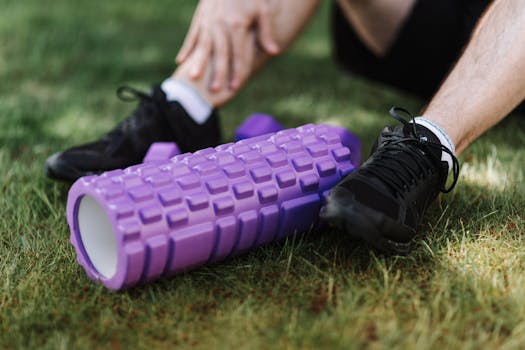Training alone can be empowering, but it also presents unique challenges. Without teammates or coaches to guide intensity, solo players are more likely to overlook recovery. Soccer injury prevention and soccer recovery are not luxuries; they are essentials for long-term performance. When you train hard without balancing recovery, your risk of injuries such as hamstring strains, ankle sprains, or groin pulls increases significantly. Building strong recovery routines helps you stay consistent and injury-free.
Why soccer recovery matters as much as training
Recovery is not just downtime; it is when your body adapts to the stress of training. Many athletes forget that improvements in strength, speed, and endurance happen while resting, not while pushing through another drill.
- Training breaks you down. Every sprint, cut, or shot stresses muscles, joints, and connective tissue.
- Recovery builds you back up. Tissues repair, energy stores replenish, and performance capacity improves.
- Solo players face higher risks. Without structured team sessions, it is easy to overtrain or skip recovery routines.
When recovery is neglected, fatigue accumulates. Over time, this weakens your ability to perform and increases the chance of injuries. Prioritizing soccer recovery helps ensure consistent progress while minimizing setbacks.
Cool-downs and mobility work: Small habits, big payoffs
A strong cool-down routine is one of the simplest ways to improve soccer injury prevention. Many players skip it, but the benefits are proven.
- Dynamic and static stretching. Use dynamic stretches before training to prime muscles. Afterward, static stretches reduce tightness and restore flexibility.
- Foam rolling and self-massage. Rolling out quads, hamstrings, and calves increases blood flow and helps muscles relax.
- Mobility drills. Focus on hips, ankles, and shoulders. These joints are critical for soccer performance and stability.
Consistency matters. Even a 10-minute cool-down can significantly reduce soreness and support long-term joint health.

Injury prevention exercises you can do alone
Soccer injury prevention does not require expensive equipment. With a few key exercises, solo players can strengthen weak areas and reduce injury risks.
- Core and stability training. Movements like planks, single-leg balances, and hip bridges improve balance and reduce stress on knees and ankles.
- Strengthening weak links. Hamstrings, glutes, and calves often lag behind quadriceps. Target them with single-leg deadlifts, Nordic curls, and calf raises.
- Prehab routines. Incorporate controlled hops, side shuffles, and resistance band exercises to prepare the body for explosive movements.
These exercises build resilience. When done consistently, they create a foundation that supports high-intensity training and prevents breakdowns.
Recognizing warning signs before they become injuries
Listening to your body is critical for soccer recovery and injury prevention. Ignoring early signals often leads to more serious problems.
- Differentiate soreness from pain. Mild soreness is normal after hard sessions. Sharp, localized pain signals potential injury.
- Watch for red flags. Swelling, limited range of motion, or recurring stiffness require immediate attention.
- Adjust intensity early. Do not push through discomfort. Modify your training before minor issues escalate.
By respecting these warning signs, you can avoid lengthy layoffs and keep your training consistent.
Rest smarter: Balancing active and passive soccer recovery
Not all rest is created equal. Knowing when to use active recovery versus passive rest improves your overall training plan.
- Passive recovery. Sleep, complete rest days, and relaxation restore energy systems. They are crucial after demanding matches or intense solo sessions.
- Active recovery. Light jogging, yoga, or cycling keeps blood moving and accelerates healing without adding heavy strain.
- Choose based on need. If you feel sluggish but not in pain, active recovery works. For deep fatigue or sharp soreness, full rest is better.
Blending both methods allows you to stay fresh while avoiding the trap of either overtraining or under-recovering.
Lifestyle recovery pillars: Sleep, nutrition, hydration
Training hard but neglecting lifestyle recovery is like driving a car with low fuel. Soccer recovery relies on three pillars: sleep, nutrition, and hydration.
- Sleep. Aim for seven to nine hours per night. This is when your body releases growth hormone and repairs tissues.
- Nutrition. Eat balanced meals rich in protein for muscle repair, complex carbohydrates for energy, and anti-inflammatory foods like berries and leafy greens.
- Hydration. Dehydration increases fatigue and slows reaction times. Regular water intake supports joint lubrication and nutrient delivery.
These invisible factors often make the biggest difference in long-term recovery and soccer injury prevention.

Managing training load and avoiding overtraining
Overtraining is one of the most common reasons solo players get injured. Without structured rest, your body cannot adapt properly.
- Schedule rest days. Plan them ahead rather than waiting until exhaustion forces you to stop.
- Rotate intensity. Alternate between hard sessions, technical drills, and lighter conditioning to avoid overloading the same systems.
- Progress gradually. Follow the principle of progressive overload. Increase training intensity step by step instead of making sudden jumps.
Properly managing load keeps performance levels high while reducing the risk of chronic injuries.
Mindset and consistency in soccer recovery habits
The best soccer injury prevention strategies only work when practiced consistently. Recovery is not a one-time fix but a long-term habit.
- Treat recovery like training. Build routines around stretching, mobility, and rest just as you plan drills and fitness work.
- Build small habits. Ten minutes of stretching or journaling soreness can create long-term resilience.
- Stay accountable. Without coaches or teammates, self-discipline is key. Tracking progress helps maintain focus.
Consistency transforms recovery from an afterthought into a performance advantage. Over time, these small habits add up to fewer injuries and stronger results.
Taking the next step in your training journey
Recovery and injury prevention are only one part of your growth as a player. To maximize your potential, you also need to focus on building your skills, structuring your training, and avoiding common pitfalls. If you want a deeper dive into why individual training matters, the core areas of solo development, and how to get started effectively, check out our resource: The ultimate individual soccer training guide. It also covers common mistakes to avoid and how to take the next step in your training journey, making it the perfect companion to the recovery strategies outlined here.
Final thoughts
Soccer injury prevention and soccer recovery are inseparable from performance. For solo players, they are even more critical. Training alone means more freedom but also more responsibility. By committing to proper cool-downs, strength exercises, active rest, and lifestyle recovery, you can reduce injury risks and maximize your potential. Consistency in these habits ensures you not only train harder but also train smarter and ultimately, play longer.
